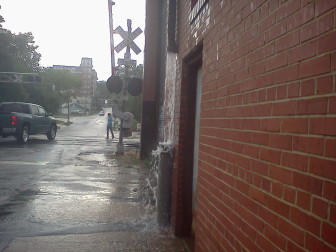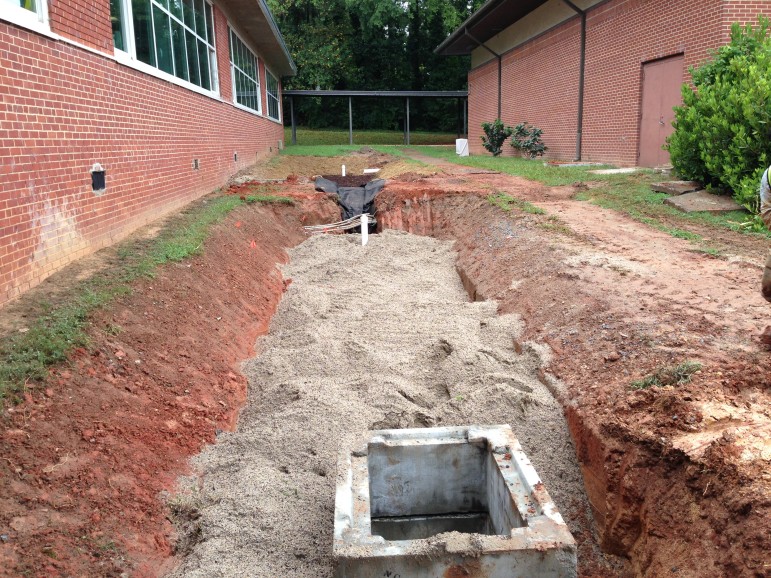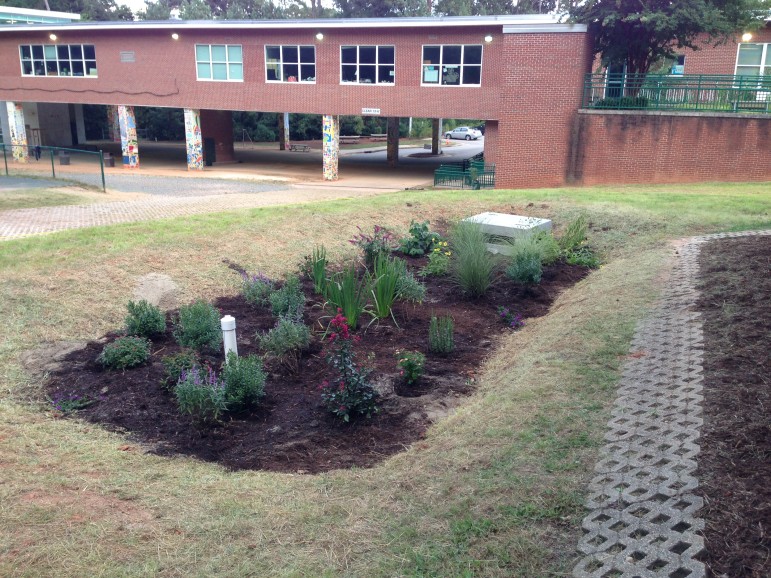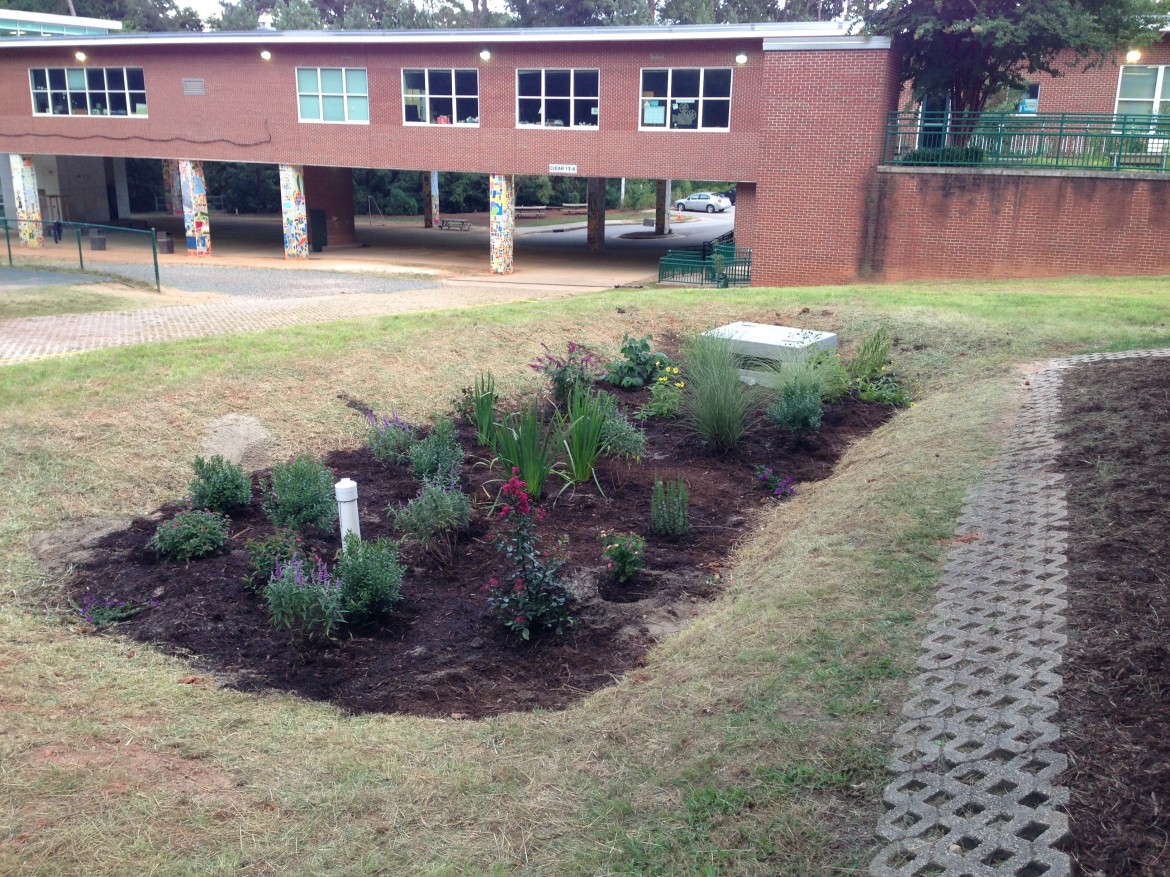Editor’s Note: This story has been updated from its original version for clarification.
When he installed a fine-gravel walkway in front of his East Raleigh home last summer, Adam Chasen had no idea he’d soon find himself in the street, collecting its scattered remains in the aftermath of a particularly heavy downpour.
“I didn’t believe the property had a ton of run-off,” said Chasen, who at the time had not installed any kind of rainwater collection system. “But between the yard and the downspout, there was enough water where it washed away the entire walkway.”

Ariella Monti
Stormwater flows from a gutter system along Hargett Street in downtown Raleigh.
When it came time to make improvements, including the installation of an underground piping system that would feed the runoff into a cistern, preventing such an incident from reoccurring, Chasen learned he wouldn’t have to front the cost alone – the City of Raleigh was there to help.
Enacted in 2009 as a way of improving the city’s water quality through Best Management Practices, the Stormwater Quality Cost Share program will pay up to 75 percent of the cost for the installation of a stormwater device, such as a cistern or a bio-retention cell, provided the property owner maintain it for 10 years. The city pays 50 percent if the agreed maintenance period is five years.
In the four years since its inception, only 16 projects, totaling $272,647 in city funding, have been approved. To date, nine have been completed at a total cost to the city of $135,527.
The city sets aside $250,000 annually for the program.
Eligibility Requirements
Raleigh Stormwater Utility Manager Danny Bowden said anyone who pays stormwater utility fees is eligible to apply for the program. Funding for the program comes from stormwater fees.
This includes everyone from individual homeowners like Chasen, whose home was built in 2012, to commercial and public land-owning entities.
Developers constructing new single and multi-family housing tracts are only qualified if they exceed the city’s stormwater quality requirements for new construction, although Bowden said this has yet to happen.
Bowden said the program is focused more on correcting problems with older properties, which were designed and built according to much less stringent requirements than exist today.
“We’re actually — how do I say this — making up for the sins of our past,” Bowden said.
Past Sins
Built in 1955, the JY Joyner Elementary Magnet School is situated on 13 acres of property in central Raleigh, just south of Crabtree Creek. Due to the slope of the property and the runoff from the large, flat roof of the school’s gym, portions of it, particularly the playground area, had become severely eroded.
In 2011, Meriwether Fentress, a member of the school’s parent-teacher association who runs her own landscape architecture firm, set out to find a solution that would not only aesthetically and environmentally improve the property but provide a learning opportunity to the school’s children as well.
Fentress reached out to local civil engineering firm Soil & Environmental Consultants and began working with its design department manager Patrick Smith, who has an extensive background in water resource management.
“There were no stormwater mechanisms out there,” Smith said. “The way they treated the stormwater was it came off the roof, through the downspout and there it went.”
This was not a result of particularly poor planning by the school’s original designers, Smith said, but rather a result of the methodology in place at the time for dealing with rainfall.
“This area that they were concerned about was originally a parking lot,” Smith said.
The parking lot was eventually replaced with the current gymnasium.
“The building itself has six downspouts,” he said. “They were pretty heavy-duty gutter systems and all that water was just kind of dumping down on the ground and washing wherever it wanted and causing erosion and poor vegetation and so on and so forth.”
The runoff was also creating additional work for the city’s water treatment facilities.
“When you have rainfall that’s coming down from the air, there’s a certain amount of nitrogen and phosphorous, it has these constituents,” Smith said. “Then when it hits a rooftop or a parking lot, it runs off and it picks up other contaminates so it kind of gets concentrated into the water course.
“The old methodology was it went straight down the pipe network and it went right into the drink,” he added.
Smith began looking into ways to capture the runoff and treat it before sending into the existing downstream pipe network and on downstream, in this case a tributary of Crabtree Creek. Although he was working on an extremely limited budget at the time, as the project’s only funding was coming from the PTA, he realized a bio-retention cell would be the best fit for the property.

Patrick Smith / Soil & Environmental Consultants
A bio-retention cell works to remove the contaminants out of the rainwater by filtering it through a sandy material composed of organics such as silt and clay. The treated water then goes through an drain that connects back to the local water system.
Once Fentress learned about the city’s cost-share program, Smith said the budget for the project increased to a total of $38,100, of which the city paid $28,575, with the PTA picking up the remainder. This money allowed for the installation of three bio-retention cells, which were completed in early September.
Fentress said some of the work on the cells, however, was left to the students.
“We’ve got a whole education program designed around this,” she said, adding that the students have planted flowers and native fauna around the cells.
Not-So-Instant Gratification
Chasen, who learned of the cost-share program through one of the founders of Raleigh City Farm, which used it to install a 55-gallon cistern, said he first reached out to the city in mid-October 2012. His contract was not executed until August of this year.
“I do have to admit, probably six months of that is my fault,” he said, indicating his failing to return some of the necessary paperwork.
“This is a very detailed document that you are signing,” Chasen said. “Any contract with the city is going take forever; attorneys have to look at it, I had to print out 10 copies have them all notarized. It’s a process.”
Chasen said he tried to turn some of his friends onto the program, but they all opted to do it themselves instead, buying the necessary supplies from hardware stores and the state surplus store and doing the installation.
“They said, ‘We want to do it now; we don’t want to wait six months.’ ”
The process for Joyner Elementary took even longer — nearly two years. Both Smith and Fentress were reticent to complain, expressing their appreciation for the City’s efforts and the program itself. Much of the delay in their case, came from the fact that the Wake County Public School System (WCPSS), the owner of the Joyner Elementary property required substantial administrative and legal review before the project could be approved. Regardless, both Smith and Fentress said they will continue to pursue similar projects with the city and WCPSS.
Fentress liked the program so much that she recommended one of her residential clients use it to install a cistern on his property. Fentress said the application and approval process for her client was much easier than the one for Joyner, as she only had to deal with the city. After determining the final cost, however – about $55,000 – the client decided that even his 25 percent portion was more than he would be willing to pay.
Despite the lengthy process, Chasen, too, had high praises for the program and the staff who helped guide him through it, particularly Bradley Stuart, an engineering technician supervisor with the city.

Patrick Smith / Soil & Environmental Consultants
The application process requires approval from the Stormwater Management Advisory Commission, which meets quarterly to decide on the projects. Once approved by SMAC, the project is then presented to City Council for final approval. Chasen said that Stuart presented his application to the Commission and the Council for him, which made the process much easier.
“I probably wouldn’t have even gone through the entire process if Bradley hadn’t been there pushing for it the entire time; they appear to be very eager to get people excited about that program and going through it, but it just takes a long time,” Chasen said.
Future of the Program
Bowden said that while participation in the program has remained steady during the past few years, it has yet to max out the yearly appropriated funding. The $250,000 annual set-aside is in the budget through fiscal year 2023, and he said as more people become aware of it and the benefits it provides, participation is likely to grow.
He added that the recent increase in flooding and erosion incidents, particularly in North Raleigh, may cause more people to look into the program, but as there is a similar cost-share program specifically for drainage control, many property owners opt to use that instead.
While more people may be drawn to the program in the coming years, the program may also find growth through those who have already gone through it once.

James Borden / Raleigh Public Record
Raleigh City Farm
Christopher Rumbley, CEO of Raleigh City Farm, used the program to install a cistern, along with piping and filter and transfer tanks at a total cost of about $30,000. He said they were extremely pleased with the outcome and plan to use it again as the farm continues to grow.
Presently, the water collected is used to irrigate the crops, which saves them from having to pay for city water. In the future, they plan to install a larger cistern and rain gardens on the site.
“It just makes a lot of sense from a sustainability standpoint,” Rumbley said.
